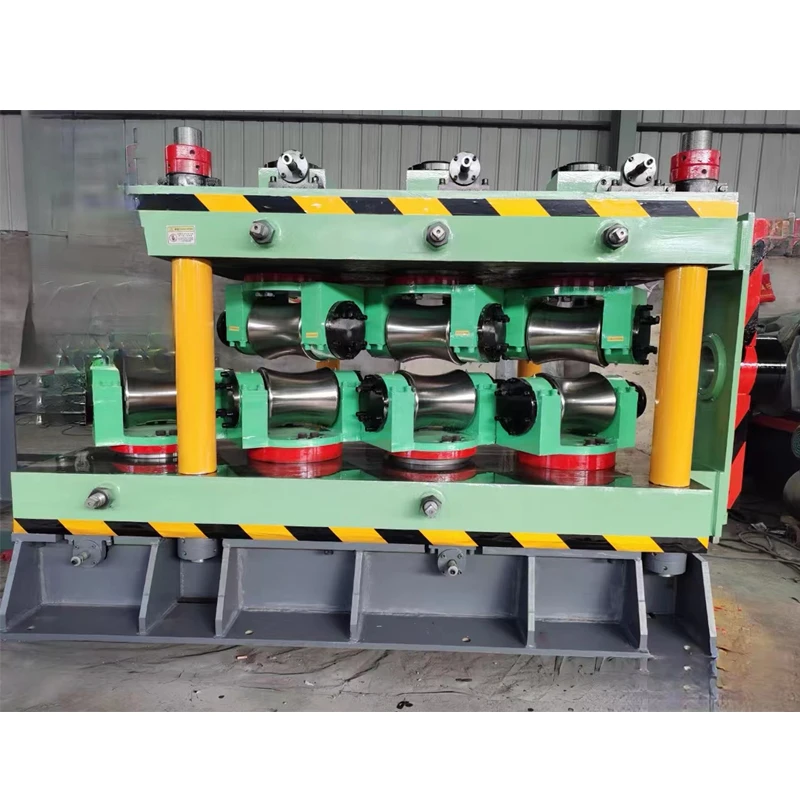roll straightening machine
The Importance of Roll Straightening Machines in Modern Manufacturing
In the world of manufacturing, precision is paramount. One key aspect that contributes to overall product quality is the shape and straightness of the materials used. This is where roll straightening machines come into play. These machines are essential in various industries, including automotive, aerospace, construction, and manufacturing, as they ensure that raw materials such as steel, aluminum, and other metals maintain the necessary specifications for further processing.
What is a Roll Straightening Machine?
A roll straightening machine is designed to straighten bent or twisted metal materials. The process involves passing the material through a series of rollers that apply pressure at specific points, effectively straightening the material to meet the desired specifications. These machines are capable of straightening a wide range of materials and sizes, making them versatile tools in modern manufacturing.
How Do Roll Straightening Machines Work?
The operation of a roll straightening machine is relatively straightforward but relies on precise engineering. The machine typically consists of multiple rollers arranged in a specific configuration. As the metal enters the machine, it passes through these rollers, which are designed to exert force at different locations along the material.
The adjustments made to the rollers allow for greater control over the straightening process. By changing the spacing between the rollers or the pressure applied, operators can manipulate the degree of straightening to achieve the needed specifications. This ability to customize the straightening process is crucial for working with different types of materials that have varying thicknesses and properties.
Applications of Roll Straightening Machines
Roll straightening machines are used in various applications. In the automotive industry, for example, they are crucial for preparing components such as frames, axles, and other structural parts. Straightening these components ensures they fit precisely during assembly, contributing to vehicle safety and performance.
roll straightening machine

In the aerospace sector, where precision is even more critical, roll straightening machines help manufacture parts that must meet strict tolerances. Components such as wings, fuselage sections, and landing gear must be perfectly straight to ensure aerodynamic efficiency and safety during flight.
Moreover, in manufacturing environments where materials are continuously processed, such as in construction or the production of home appliances, roll straightening machines play a vital role. They help maintain the integrity of metal components, reducing waste and ensuring that the finished products meet high standards of quality.
Advantages of Using Roll Straightening Machines
Investing in roll straightening machines offers several advantages. First and foremost, they significantly enhance the quality of finished products by ensuring that materials are straightened to precise specifications. This leads to fewer defects and a reduction in scrap material, which in turn lowers production costs.
Additionally, modern roll straightening machines often come equipped with advanced control systems that allow for automated adjustments. This automation not only increases efficiency but also minimizes the risk of human error during the straightening process.
Furthermore, these machines are designed to be robust and durable, capable of handling high volumes of materials without compromising performance. The use of high-quality materials in the construction of roll straightening machines ensures longevity and reliability, making them a worthwhile investment for any manufacturing operation.
Conclusion
In conclusion, roll straightening machines are essential tools in modern manufacturing processes. Their capacity to deliver precision and consistency in the straightening of metal materials makes them indispensable across various industries. As manufacturing continues to evolve, the role of roll straightening machines will remain critical in ensuring high-quality production standards and meeting the demands of an increasingly competitive market. Therefore, companies investing in these machines are not just optimizing their processes but also securing a competitive edge in the marketplace.
-
High Frequency Straight Seam Welded Pipe Production Line|BzZhou Xinghua|Precision Welding&EfficiencyNewsJul.30,2025
-
High Frequency Straight Seam Welded Pipe Production Line - BzZhou Xinghua|Precision Engineering&EfficiencyNewsJul.30,2025
-
High-Frequency Straight Seam Welded Pipe Production Line-BzZhou Xinghua Machinery Equipment Manufacturing Co., LTD.NewsJul.30,2025
-
High-Frequency Straight Seam Welded Pipe Production Line-BzZhou Xinghua Machinery Equipment Manufacturing Co., LTD.|Precision Manufacturing, High EfficiencyNewsJul.30,2025
-
High Frequency Straight Seam Welded Pipe Production Line-BzZhou Xinghua Machinery Equipment Manufacturing Co., LTD.|Precision Steel Pipe Manufacturing&Industrial EfficiencyNewsJul.29,2025
-
High-Frequency Straight Seam Welded Pipe Production Line-BzZhou Xinghua Machinery Equipment Manufacturing Co., LTD.|Precision Steel Pipe Manufacturing&Industrial EfficiencyNewsJul.29,2025


